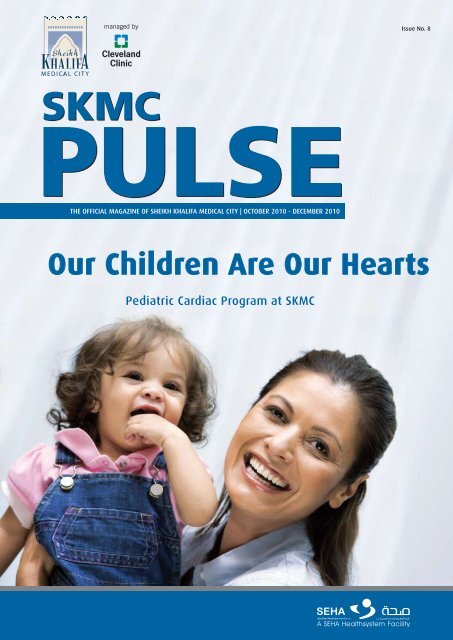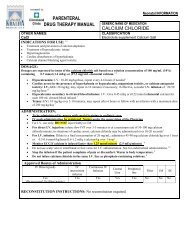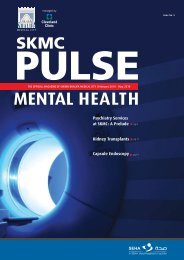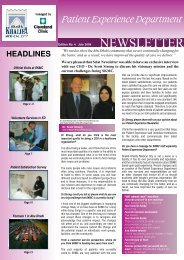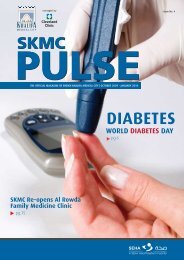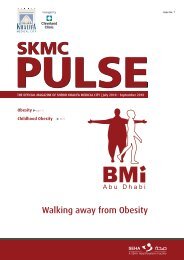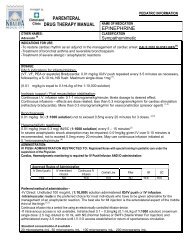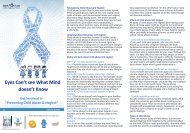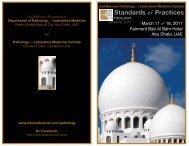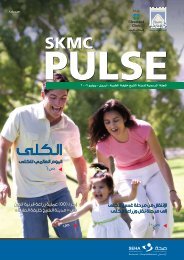SKMC PULSE Issue No. 8 - Sheikh Khalifa Medical City
SKMC PULSE Issue No. 8 - Sheikh Khalifa Medical City
SKMC PULSE Issue No. 8 - Sheikh Khalifa Medical City
Create successful ePaper yourself
Turn your PDF publications into a flip-book with our unique Google optimized e-Paper software.
<strong>Issue</strong> <strong>No</strong>. 8THE OFFICIAL MAGAZINE OF SHEIKH KHALIFA MEDICAL CITY | OCTOBER 2010 - DECEMBER 2010Our Children Are Our HeartsPediatric Cardiac Program at <strong>SKMC</strong>
IN THIS ISSUE<strong>No</strong>te from the CEO……………………………………………………. 4Cleveland Clinic Updates......................................................... 5Pediatric Cardiac Program................................................... 6-8Cardiac Health ......................................................................... 9Successful Procedures of the Fourth Quarter.................. 10-11'Happened in ER' (A Thorn in My Boy’s Foot).................... 12New Consultants at <strong>SKMC</strong> .................................................... 13Conferences and Symposiums at <strong>SKMC</strong>............................... 14Quarterly News ................................................................ 15-16<strong>SKMC</strong> Fourth Quarter & 2010 Data ...................................... 1710“Minimally Invasive Vein Harvesting”15 16Editor in Chief:Mohamad Aboufares, Marketing and Communications DirectorEditor:Salwa Younis, Senior Health Education OfficerContributors:Dr. <strong>No</strong>rbert Augustin MD, ABS, FACS,Chair of Cardiac Sciences InsititueDr. Alawi Alsheikh-Ali MD, MS, FACC, Consultant CardiologistDr. Laszlo Kiraly, MD, FETCS,Head, Consultant, Pediatric Cardiac SurgeryDr. Ahmed A. M. Ali,MRCPI, MRCSed Accidents & Emergency, ER SpecialistEllen Edwards, Section Head, Clinical DieteticsWendy Thompson, Nursing unit Manager, PCICU16P.O. BOX 51900 | ABU DHABI, UAE | TEL: +971 2 819 0000 | FAX: +9712 819 4962 | www.skmc.ae
NOTE FROM THE CEODear Reader,<strong>No</strong>w that the year is over, I can confirm that 2010 is a year in which we strengthened ourposition on the successes of the past as well as we built new capabilities for delivering highquality healthcare and operational excellence. I am proud to say that Patient Satisfactioncontinues to increase, with 97% of admitted patients stating that they would recommendus. This staggering increase is driven mainly by the large drop in the waiting times at ourOutpatient Specialty Clinics (OSC) and the improved customer service plan, which will entera new dimension with the implementation of the Patient Experience Map in 2011, similar towhat Cleveland Clinic, Ohio has.As Quality will always be our focus, we continue to create the proper infrastructure for besthealthcare delivery by creating the right gate keepers for our medical practices as we expandedthe mortality and morbidity reviews and adjusted its policies, plus many other indicators.Throughout this year also, we have been surveyed by HAAD and other international bodies andthe outcomes assured our readiness in terms of quality standards.Operationally, in addition to the OSC restructuring, the Emergency Department and theOperating Room went through similar improvement projects leading to better handling ofpatients and a reduction in the cancellations of surgeries. Cost reduction initiatives continue tobe the focus and performance management metrics are being introduced to all departments.Work on automation and implementations of SEHA driven initiatives continues to bring benefitsto our processes.Moreover, we established the Office of Professional Staff Affairs (OPSA), modeled after theCleveland Clinic, which is expected to result in significant improvements in physician recruitment,orientation, retention and turnover rates. Furthermore, we witnessed the renovation of ourcafeteria to better serve our patients and staff and we launched our new website to reflect thestate at which the <strong>Medical</strong> <strong>City</strong> is at.Finally, and as in last year, our patient volumes continued to increase as you continue to choose<strong>SKMC</strong> as your healthcare provider of choice. Our outpatient specialty visits increased by 7%compared to last year and our Emergency Department increased its volume by 12%.Thank you for your trust in our healthcare system.Patients First,Tej Maini, MD, FACSChief Executive Officer<strong>Sheikh</strong> <strong>Khalifa</strong> <strong>Medical</strong> <strong>City</strong>4
CLEVELAND CLINIC UPDATESCLEVELAND CLINIC GENOMIC MEDICINERESEARCHERS FIND CORRELATION BETWEENHEAD SIZE AND COLON CANCER RISKCowden Syndrome Detection Will Allow for EarlyDiscovery of Cancerous PolypsResearchers in Cleveland Clinic’s Genomic Medicine Institute havefound a strong correlation between large head circumferenceand cancer risk in patients with Cowden syndrome.Published in the December 2010 issue of the journalGastroenterology, the research focused on 127 patients whocarry the genetic mutation that causes Cowden syndrome, whichis associated with an increased risk of breast, thyroid and uterinecancers. Among these patients, large head circumference wasthe most common clinical trait.“What this means is that people with big heads – defined asgreater than 58 centimeters in men and 57 centimeters inwomen – should see a genetic counselor to determine whetherthey should be screened for colon, breast, thyroid and uterinecancers,” said lead researcher Charis Eng, M.D., Ph.D., HardisChair of the Genomic Medicine Institute in Cleveland Clinic’sLerner Research Institute.Prior to Cleveland Clinic’s research, the medical literatureestimated that just 25 percent of Cowden patients had largehead circumferences. This study, though, found a much highercorrelation, with 74.8 percent of the Cowden patients exhibitinglarge head size.CLEVELAND CLINIC UNVEILS TOP 10MEDICAL INNOVATIONS FOR 2010Hospital Experts Predict Ten Emerging TechnologiesThat Will Shape Health Care Next YearThe list of breakthrough devices and therapies was selected by a panel ofCleveland Clinic physicians and scientists and unveiled during Cleveland Clinic’s2010 <strong>Medical</strong> Innovation Summit.Four major criteria served as the basis for qualifying and selecting the Top 10<strong>Medical</strong> Innovations. <strong>No</strong>minated innovations were required to:· Have significant potential for short-term clinical impact (either a majorimprovement in patient benefit or an improved function that enhanceshealthcare delivery).· Have a high probability of success.· Be on the market or close to being introduced.· Have sufficient data available to support its nomination.The Top 10 <strong>Medical</strong> Innovations for 2010 are:10. Capsule endoscopy for diagnosis of pediatric GI disorders:A pill-sized camera captures 50,000 high-resolution images during itspainless six- to eight-hour journey through the digestive tract, provingbetter than x-ray at detecting small bowel ulcerations, polyps and areasof bleeding.9. Oral disease-modifying treatment for multiple sclerosis:Before fingolimid was approved by the FDA this year, MS drugs had tobe injected or infused on a regular basis. This oral medication effectivelystops T-cells from attacking the myelin sheaths that cover nerve fibers.8. Exhaled nitric oxide (NO) breath analysis for diagnosing asthma:A new hand-held diagnostic testing device measures a patient’s levelof exhaled NO, which is a biomarker for asthma. Monitoring NO levelsallows doctors to more accurately tailor treatment strategies.7. Transoral gastroplasty, or TOGA:A new experimental weight-loss option for obese patients who wantto lose weight and improve their health without undergoing major surgery.This “scar-less” procedure represents a significant improvement inminimally-invasive bariatric surgery and losses approaching 40 percentof excess body weight can be expected within a year.6. Telehealth monitoring for heart failure patients:Miniature implantable monitors to measure pulmonary artery pressuredaily and at-home devices to monitor weight, heart rate and blood pressureof heart failure patients allow doctors to adjust medication quickly,improving patient outcomes and quality of life, while reducing re-hospitalizations.5. Hepatitis C protease-inhibiting drugs:Two drugs awaiting FDA approval treat hepatitis C using protease inhibitors,which work by blocking a key enzyme that viruses need to copythemselves and proliferate. In clinical trials, cure rates for the proteaseinhibitors are higher than current hepatitis C treatments, with fewer sideeffects.4. JUPITER study and statins for healthy individuals:The JUPITER (Justification for the Use of Statins in Primary Prevention: anIntervention Trial Evaluating Rosuvastatin) trial pointed out for the firsttime that many seemingly healthy people are at higher risk for heartdisease than previously thought, suggesting that statins should be prescribedeven to people with low LDL (bad cholesterol), if they have highC-reactive protein levels.3. First therapeutic cancer vaccine approved by the FDA:While not a cure for prostate cancer, sipuleucel-T is the first cancer vaccineto receive FDA approval. Prescribed to men with advanced prostatecancer, the drug coaxes their own immune systems into attacking andremoving the cancer, reducing the risk of death by 24 percent comparedto placebo.2. Anti-CTLA-4 drug (ipilimumab), a targeted T-cell antibody formetastatic melanoma:The effectiveness of ipilimumab in treating melanoma confirms the roleof immunotherapy as an effective treatment. In patients with advancedstage III or IV melanoma, 23 percent were still alive after two yearscompared to 14 percent of patients who received standard treatment.1. New molecular imaging biomarker for early detection of Alzheimer’sdisease:Currently, positive diagnosis of Alzheimer’s is only possible upon autopsy.But a radioactive molecular imaging compound called AV-45 anda PET scan can allow doctors to “see” inside patients’ brains to detectbeta-amyloid plaques, the tell-tale signature of Alzheimer’s.“The Top 10 list reflects the place of Clinic physicians as arbiters of innovation.It goes all over the world, usually with a forward of an emailcommending the recipient that if the technology is important to ClevelandClinic it should be important to you,” said Christopher Coburn, ExecutiveDirector, Innovations, the Cleveland Clinic’s corporate venturing arm.5
Pediatric Cardiac Program at<strong>Sheikh</strong> <strong>Khalifa</strong> <strong>Medical</strong> <strong>City</strong>The large young population of the UAE and the critical needs of pediatricpatients with congenital heart disease dictated the need for a nationalservice center in pediatric cardiac care. With its Pediatric Cardiac Program,<strong>SKMC</strong> is able to treat neonates and children suffering from cardiac problemsin the UAE; rather than sending them abroad for treatment. As most of thesenewborns would require immediate surgical interference after birth, theexistence of such a program saves their lives and minimizes their sufferingby providing them with a healing environment amongst their families andculture.<strong>SKMC</strong>’s Pediatric Cardiac Program team consists of internationally recognizedpediatric cardiac surgeons, pediatric cardiologists, cardiac intensive care andanesthesia physicians. The team has access to a Pediatric Cardiac OperatingRoom, Pediatric Cardiac Intensive Care Unit (PCICU) with a capacity of 9 bedssupported by High Dependency Unit (HDU) of 5 beds, the pediatric wardsand auxiliary service of a pediatric cardiac catheterization laboratory, noninvasivecardiology and outpatient clinics.<strong>SKMC</strong>’s Pediatric Cardiac Surgery Program is the only pediatric cardiactreatment center in the UAE that provides its services around the clock,offering complex neonatal cardiac repairs. With more than 55 arterial switchoperations and almost 50 hybrid procedures performed since its openingin April 2007, the program has more than 900 procedures in its records.Moreover, several first of its kind surgeries in the UAE were successfullyperformed by <strong>SKMC</strong>’s Pediatric Cardiac Surgery team during the past threeyears, such as a modified <strong>No</strong>rwood-1 operation for hypoplastic left heartsyndrome (HLHS), Damus-Kaye-Stansel operation, double switch operation,Ross-procedure and baby-Ross procedure with homograft implantation.Moreover, the team performs all kinds of open heart surgeries for neonates.Since two-third of our patient population is neonates and/or infants lessthan six months of age, the median complexity of cases far exceeds thatof the international average. When compared to standards of internationaldatabases (e.g. European Association for Cardio-Thoracic Surgery (EACTS)Congenital Database), <strong>SKMC</strong>’s results are superior, both in terms of survivalrate and length of stay.Pediatric Cardiac Surgeries: Complexity ChartSimple21%MostSimple16%MostComplex45%Complex18%6
Pediatric Cardiac CatheterizationThe pediatric surgical program is complemented by the pediatric cardiologyprogram creating a continuum of care on in-hospital and outpatientsconsultations as well as all the modalities of non-invasive / invasiveinvestigations including cardiac catheterizatin. The interventional pediatriccardiologists at <strong>SKMC</strong> have performed about 350 catheters, most of whichwere catheter interventions.Hybrid approach to care<strong>SKMC</strong> adopts the Hybrid approach in care which is a very modern andemerging multidisciplinary therapeutic modality where the pediatric cardiacsurgeon and pediatric cardiologist work closely together to perform theirrelevant parts in the same procedure. These procedures are performed inthe catheterization laboratory that also acts as a full cardiac operation room.This therapeutic modality is only available in the most advanced medicalcenters around the world.Unique offerings of <strong>SKMC</strong> (amongst feworganizations worldwide and first in the Gulf)•Extracorporeallife support (Extra-Corporeal Membrane Oxygenation =ECMO, “artificial heart”) therapy is utilized in situations where the heartis unable to maintain the circulation. In such instances, it is literally thequestion of life-or-death to avail such a therapeutic modality. ECMO is atypically multidisciplinary effort, performed by specially trained ECMOnurses,the surgical, perfusion and medical teams. ECMO is applied tobridge various forms of pre/postoperative cardiogenic shock.•<strong>SKMC</strong>’sPediatric Cardiac team has developed good cooperation withother SEHA hospitals for the Patent Ductus Arteriosus (PDA) ligation ofpreterm neonates with extremely low bodyweight (the smallest patientweighted only 450g!). PDA ligation is a corrective surgery for childrenwhose Ductus Arteriosus did not close after birth.Overall ServicesThe Pediatric Cardiac Program at <strong>Sheikh</strong> <strong>Khalifa</strong> <strong>Medical</strong> <strong>City</strong> (<strong>SKMC</strong>), managedby Cleveland Clinic, provides unparalleled service to the entire communityfrom neonates to grown-ups with congenital heart disease. Our servicescover the following:•24/7 (all-around) service for emergency/urgent and elective treatment•of congenital heart disease (CHD)Treatment possibility from neonatal complex repairs to grown-up congenitalcardiac care (GUCH)Predominantly primary repairs and staged operationsPediatric cardiology: non-invasive/invasive; catheter interventionsHybrid pediatric cardiac surgery program•Extracorporeal life support (ECMO)Comprehensive continuity of care (preoperative/operative/postoperative/follow-up)350300250200150100500<strong>SKMC</strong> Pediatric Cardiac Surgery:Surgical Volume802052923242007 2008 2009 20107
Pediatric Cardiac ICUThe vision of The Pediatric Cardiac Intensive Care Unit is to provide anoutstanding experience, in terms of quality of care, superior clinical outcomesand improved quality of life for the children and families it serves.The Pediatric Cardiac Surgery Program started in April 2007 and has grownfrom 80 surgical cases in 2007 to 324 surgical cases in 2010.<strong>SKMC</strong> Pediatric Cardiac Intensive Care Unit (PCICU) is staffed with a teamof expert cardiac physicians and pediatric critical care nurses. While mostof our patients are those who are admitted after cardiac surgery, thePCICU also cares for patients with non-surgical conditions, such as heartfailure and myocarditis, and children with heart disease undergoing noncardiacsurgery.The 9-bed unit features private patient rooms (directly located next to theCardiac OR) with facilities designed to provide optimal family-centered care.The PCICU is also linked to a Pediatric High Dependency Unit. PCICU providesstate-of-the-art recovery and monitoring techniques designed specificallyfor recovering pediatric cardiac surgery patient. The team employs thelatest technologies, such as rapid deployment of Extracorporeal MembraneOxygenation (ECMO).Currently PCICU have 6 trained and certified ECMOSpecialized Registered Nurses. They have all been trained in Leicester, theleading ECMO Center in the UK.The PCICU staff is a multidisciplinary team dedicated exclusively to treatingneonates and children with critical cardiac needs. PCICU is the region’stertiary referral facility. In addition to the nurses the staff includes a clinicalpharmacist, respiratory therapists, dietician, as well as physicians from thedivisions of critical care medicine, cardiology and cardiac surgery. Daily roundsensure optimal assessment and review of patient’s status and ongoing careneeds.The PCICU is unique for the quality of care, outcomes and commitment to thechildren and families served.8
5-2-1-0for Your Kid’s Healthy Heartsand Weights5 Fruits and Vegetables•It’s recommended that kids eat at least five fruits and vegetables a day.Parents can add fruits and vegetables into their Kid’s three main meals•and snacks.Try to offer raw fruits and vegetables if possible; it can be as easy as•apple slices or carrot sticks for snack time.Encourage children to eat fruits and vegetables. They are higher in fibercontent and nutrients, than 100% juices that are high in sugar.The vitamins and minerals in fruits and vegetableshelp kids grow, fight off illness and can preventweight gain. Fresh is best, but frozen is also a goodchoice. If you're using canned fruits and vegetables,watch for sodium and added sugar.2 Hours or Less of Television or Computer Time Per day•Dedicate a quiet time for reading and homework …Limit the time your children watch television, play video games, or surfthe web to no more than two hours per day.•Additionally, the American Academy of Pediatrics (AAP) does notrecommend television viewing for children age 2 or younger.1Hour of Active PlayLack of exercise is a major cause of obesity. One hour of active play canmake a difference in your child’s health.What•Is Active Play?<strong>No</strong> equipment required. The only rules for active play are:1 Get your heart and your kid’s heart pumping2 Get one hour or more of moderate to vigorous physical activityevery day, such as walking, playing ball or racket games, steps,slides at the park and swimming.•Active kids may become active adults and children imitate adults!Start adding physical activity to your own daily routine and encourageyour children to join you.0 Sugary Drinks•Kids (ages 2-10) should drink water and 1% or fat-free white milk•instead of sugar-sweetened drinks and whole milk.Soda, sports drinks, chocolate milk, and juice have a lot of sugar, which•adds empty calories.Sugary drinks lead to tooth decay and end up replacing milk in children's•diets.Skim or 1% white milk is best for kids. They don't need the extra fat andcalories in whole milk.Remember to feed your child everyday a small amountof the following: lentils, dried beans, pulses, meat,chicken or fish.9
SURGICAL PROCEDURESMinimally Invasive Vein Harvesting forCoronary Artery Bypass Grafting Surgery<strong>No</strong>w Available at <strong>Sheikh</strong> <strong>Khalifa</strong> <strong>Medical</strong> <strong>City</strong>Cutting-Edge Method Offers Many Benefits to Bypass PatientsThis is a scarring comparison between patients who underwent EVH (Top)compared to a patient who underwent the traditional open method (Below).The Cardiac Sciences Institute at <strong>SKMC</strong>, Chaired by Dr. <strong>No</strong>rbertAugustin is the only team in the UAE that can successfullyperform minimally invasive Endoscopic Vein HarvestingProcedure instead of a traditional open operation.About Coronary Artery Bypass SurgeryCoronary artery bypass grafting reroutes blood aroundblocked arteries to improve blood flow and oxygen to theheart. The procedure involves taking, or harvesting, a veinor artery from another part of the body, typically the leg,and sewing or grafting the vessel to the coronary artery tobypass the clogged artery and restore blood flow.Obtaining the Healthy Vein or ArteryTraditionally, the vessel is removed from the leg througha long incision that may stretch from the ankle to thegroin. In addition to a long, visible scar, some patientsexperience more postoperative pain from the leg incisionthan from the chest incision. Rehabilitation may also bedelayed because the leg incision makes it more difficultfor the patient to stand or walk after surgery.New Method for bypass surgeryEndoscopic Vessel Harvesting(EVH) offers patients aminimally invasive alternative for obtaining the vein orartery. Using the Endoscopic Vessel Harvesting System, thevessel can be removed through one to three very smallincisions. During the procedure, an endoscope is connectedto a video camera and inserted into the incision, providingthe surgeon with the view needed to find the vessel. Next,the surgeon creates a working tunnel in order to removethe vessel with minimal stress on the leg. This procedureis designed to reduce the surgical trauma to the patientand decrease the incidence of wound healing problems.Benefits of Endoscopic Vessel Harvesting1. Reduced pain2. Reduced blood loss3. Reduced risk of infection4. Shorter hospital stay5. Faster recovery6. Faster return to work7. Excellent cosmetic resultsOld Method for bypass surgery10
SURGICAL PROCEDURESThe Cardiac ArrhythmiaService at <strong>SKMC</strong>The Cardiac Arrhythmia Service is an integral part of the Cardiac SciencesInstitute at <strong>SKMC</strong>. The service is staffed by two consultant electro-physiologistsand two specialist physicians and provides care for a wide spectrum of heartrhythm conditions. This involves both outpatient and inpatients consultations,pharmacologic management of common arrhythmias, invasive evaluationand treatment of atrial and ventricular arrhythmias, and implantation andfollow up of cardiac pacing and defibrillation devices. The Arrhythmia Servicetypically sees more than a thousand patients in the outpatient departmentand interprets more than 1,000 Holter recordings annually.The electrophysiology laboratory at <strong>SKMC</strong> is equipped with state of the artintracardiac recording and mapping technology enabling <strong>SKMC</strong> consultantsto perform complex invasive procedures for the diagnosis and treatmentof cardiac arrhythmias. Since its inception nearly 3 years ago, heart rhythmconsultants at <strong>SKMC</strong> have implanted more than 300 cardiac rhythm devicesincluding pacing and defibrillation devices designed to resynchronizecardiac contraction. Invasive electrophysiologic studies with therapy usingradiofrequency ablation of arrhythmias are routinely performed at <strong>SKMC</strong> andmore than 200 such procedures have been done to date treating both atrialand ventricular arrhythmias.The Arrhythmia Service is recognized as a referral Service for heart rhythmdisorders and sees patients from all over the UAE. Members of the ArrhythmiaService are also actively involved in heart rhythm research including a Gulfwide survey of the common arrhythmia atrial fibrillation.11
A THORN IN MY BOY’S FOOTThis is a summary of a real story from Dr.Ahmed Ali’s book “Happened in ER” thathas been recently published in Arabic.The book is interestingly informative with anice sense of humor.We've all been there; a foreign body would enter, by mistake, into ourbodies. A child would swallow a coin, a nail or a needle, someone wouldmanage to get a wooden stick or a nail into their foot, or a little piece ofmetal would get into someone's eye, while working with metal parts.This story happened to a six-year-old boy, who was playing on the beach inAbu Dhabi, and meanwhile, a piece of metal got into his foot.The strange and funny thing is that the boy burst out screaming violently,and his family members who were with him tried hard to pull it out, butthey failed. So they called the ambulance that came to the beach, andkindly delivered the boy to the ER.Is that even possible?! To call the Ambulance for just a piece ofmetal in the foot?!Well, that is what happened, and it seems like that was the only choice.The paramedics' entrance into the ER was dramatic, and everyone overthere stood to watch that bizarre scene.I was one of those who saw the scene and helped treat the boy afterwards.Two paramedics entered, one of them was carrying the boy, and the otherwas carrying the piece of metal that was still sticking out of his little foot.It is now time to describe the piece of metal to you, it is not a sharp littlemetallic stick as you might have thought, this thing was a long metallictool, almost a meter long, ending in three sharp extensions, it looks just likea table fork, and is usually used to collect jellyfish on the beach by holdingit vertically and then strongly stick it into the jellyfish.The little boy was on the beach with his older siblings, and upon seeingthem use that tool, he decided to try it out for himself.For the first time in his life, he held the stick by its end and attempted tostick it into the jellyfish, and..OOOPS! He missed! He managed to stick itright into his bare foot, and one of its sharp extensions penetrated his footand stuck out at the other side.At the ER, it was a dreadful scene, a little boy, less than a meter tall, heldby the paramedic, while the other paramedic holds the tool, which wasalso about a meter long, in a very careful manner, for any movement wouldhave caused the boy agonizing pain. The boy was placed very carefully onthe bed, while one of the paramedics was still holding the metallic tool.The mother had been really strong, which helped the ER team a lot,She was using her mobile phone to take photos of the scene, moved byexcitement and anxiety.The aim was to take the metallic tool off the boy's foot without hurtinghim. It is important in such a situation is to deal with the child as an adult,by conversing with him and explaining in detail exactly what is going tohappen, and to avoid attacking him with a sudden pain.After a lot of persuasion and a few tears, a subcutaneous anestheticinjection was given to the boy, and he was left for a little while, then, wegot ready for taking the tool off.And that was the dilemma!The fork-like metallic tool consisted of a long metallic handle that endsin three, V-shaped extensions pointing outwards; this makes its motionpossible in only one way. Can you imagine that?That is why the tool cannot be pulled upwards, if we do so, we are goingto rip the boy's flesh off, and that is the reason his family could not simplytake it off on the beach.If the tool was a handle with only one extension, we would have been ableto push it in the direction of his foot and pull it out on the other end, but ithad three extensions.So, what can we do?The only way to take it out was to break the sharp part out of the boy'sfoot. So what we did was that we pushed the tool into the boy's foot a littlefurther, until the V-shaped extension came fully out of the bottom of thefoot, and, using a bone-cutting forceps, which is a strong and sharp nipperused for cutting bones.We went through the first attempt...Twice... Thrice ... And BANG!Finally the metal broke, and every onesighed in relief.The tool was pulled carefully and slowlyout of the boy's foot until it was out,and the X-rays showed afterwards thatthere were luckily no injuries in thefoot bones.The boy went out of the ER on his feet,hobbling a little because of the wound,holding the big tool in his little handand waving goodbye to everyone.12
Welcome to <strong>SKMC</strong>Newly Appointed ConsultantsNEW CONSULTANTSDr. Ammar AbdulbakiDr. Ammar Abdulbaki, a US national whograduated from Damascus University medicalschool, Syria in 1992. He moved to USto enhance his further studies and obtainedfellowships in nephrology (1999) and transplantnephrology in 2003 respectively. He isan American Board Certified Nephrologist.Prior to joining <strong>SKMC</strong> he was Renal TransplantConsultant at King Faisal Specialist Hospital & Research Center, Riyadh,Saudi Arabia for 6 years.Dr. Kalpana Krishna ReddyDr. Kalpana Krishna Reddy, an Indian nationalwho graduated from Bellary <strong>Medical</strong> College,India in 1997. She achieved Fellowship fromRoyal College of Anesthetists, London in 2003.She also has European Diploma in IntensiveCare Medicine as well as dual accreditation inIntensive Care Medicine and Anesthesia. Shewas a consultant in Anesthesia and IntensiveCare Medicine, University Hospital, Lewisham,lewisham High Street, UK prior to joining <strong>SKMC</strong>Dr. Stefan WeberDr. Stefan Weber, a German national whograduated from University of Aachen <strong>Medical</strong>School, Germany in 1989. He completed Residencyin Microbiology from Institute for <strong>Medical</strong>Microbiology (RWTH) Aachen, Germany In1991. He is a German Board certified physicianin Microbiology & Epidemiology. He has over11 years of experience in his respective field.Prior to joining <strong>SKMC</strong> he was <strong>Medical</strong> Director,Bioscientia <strong>Medical</strong> Center, and Saarbruecken Hospital, Germany.Dr. Hasnain ShahDr. Hasnain Shah, a US national who graduatedfrom McGill University, Faculty of Medicine,Canada in 2000. In 2005 he became anAmerican Board Certified Radiologist. He didRadiology Residency at Henry Ford Health System,Detroit, USA. He obtained Fellowships inVascular Interventional Radiology and Neuroradiologyand Interventional Radiology in 2006and 2007, respectively, from Henry ford Health System. He has over4 years of experience in his specialized field. Prior to joining <strong>SKMC</strong>he was Director of Neurointerventional Service and InterventionalPain Management and Vice Chair of Radiology at Superior ImagingServices Inc, Interventional and Vascular Institute of <strong>No</strong>rthern Michigan,Marquette General Hospital, USA.Dr, Richard LoffhagenDr, Richard Loffhagen, a British nationalwho graduated from St. Bartholomew<strong>Medical</strong> School, London in 1997 and obtainedMRCP(London) in 2000. He became Fellowof College of Emergency Medicine UK aswell as CCT- UK in 2006. He has many yearsof experience as Specialist Registrar inEmergency Medicine with various hospitals inUK. Prior to joining <strong>SKMC</strong> he was consultant in Emergency Medicinewith Cheltenham Hospital UK.Dr. Angella McCannDr. Angella McCann, a British national who gother MBChB from University of Dundee, Scotlandin 1999. In 2006 she became a memberof Royal College of General Practitioners(London). She also has Diplomas from RoyalCollege in Obstetrics & Gynecology, TropicalMedicine, Sexual and Reproductive Health. Sheworked as a Consultant in Family Medicine inthe UK for the past three years prior to joining <strong>SKMC</strong>.Dr. Maan TabaDr. Maan Taba, a Spanish national who graduatedfrom <strong>Medical</strong> School at Granada University,Spain in 1986. In 1989 he got his masters in generalSurgery from Complutense University, MadridSpain. He had his residency training in orthopedicand trauma Surgery during 1987 - 1992 from Hospital12 de Octubre, Madrid, Spain. He achievedhis Fellowship from Royal College of Surgeons ofEngland in 2005. He has been a CCST certified orthopedic surgeon since1992. Prior to joining <strong>SKMC</strong> he was a Consultant Orthopedic Surgeon withspecial interest in lower limb with Basildon University Foundation Trust.13
CONFERENCES AND SYMPOSIUMS<strong>SKMC</strong> ‘s Second Annual Transplantation Symposium<strong>Sheikh</strong> <strong>Khalifa</strong> <strong>Medical</strong> <strong>City</strong> (<strong>SKMC</strong>), managed by Cleveland Clinic, organized the second annual transplantation symposium on 5 & 6 <strong>No</strong>vember 2010 at thePark Rotana Hotel, Abu Dhabi. More than 400 nurses and other healthcare professionals who are also interested in transplantation care and organ donationattended the first day and about 200 physicians attended the second day. The nurses earned 5.5 hours of accredited Continuous <strong>Medical</strong> Education (CME)and physicians earned 5 CME hours.The <strong>SKMC</strong> Kidney Transplant team has preformed 35 kidney transplants since February 2008, with outcomes that are as good as or better than internationallypublished results; 2 of which were for children below 10 years of age.<strong>SKMC</strong> Inaugurated the SecondAnnual Obesity SymposiumUnder the Patronage of H.E. <strong>Sheikh</strong> Nahayan Bin Mabarak Al Nahayan,Minister of Higher Education and Scientific Research, <strong>Sheikh</strong> <strong>Khalifa</strong><strong>Medical</strong> <strong>City</strong> (<strong>SKMC</strong>), managed by Cleveland Clinic inauguratedthe second annual symposium on obesity under the title of “TheManagement of Obesity, Metabolic Syndrome and Updates in MinimallyInvasive Surgery” on 16 October 2010 at the Sheraton Resort and Hotel,Abu Dhabi. More than 400 Physicians/surgeons of different specialtiesattend the symposium and earned 17CME hours.The symposium had been organized in cooperation with the ClevelandClinic, Ohio, and the <strong>SKMC</strong> Diabetes and Endocrinology Center. Physiciansconsider it a great opportunity to discuss new cutting-edge trends andtechniques used in the field of minimally invasive surgeries with otherhealthcare providers interested in surgical interventions and strategiesto treat diabetic patients. Dr. Nimeri, Director of Bariatric and MetabolicInstitute – Abu Dhabi at <strong>SKMC</strong> and Chairperson of the symposium said“Bariatric surgery is not just weight loss surgery, or cosmetic surgery. Itcan save lives, and help patients with the metabolic syndrome<strong>SKMC</strong> Marked theWorld Diabetes DayAs part of its commitment towards health education and promotion,<strong>Sheikh</strong> <strong>Khalifa</strong> <strong>Medical</strong> <strong>City</strong> (<strong>SKMC</strong>), managed by Cleveland Clinic,celebrated the World Diabetes Day on Friday, 26 <strong>No</strong>vember 2010The World Diabetes Day, which falls on the 14th of <strong>No</strong>vember annually,marks the primary global awareness campaign of the InternationalDiabetes Federation and United Nations. The International DiabetesFederation (IDF) is an umbrella organization for over 200 memberassociations in more than 160 countries, advocating for the more than250 million people with diabetes, their families, and their healthcareproviders. Its mission is to promote diabetes care, prevention and acure worldwide.The event, organized by a multidisciplinary team from <strong>SKMC</strong>’s Diabetesand Endocrinology Clinic, took place at the Khalidiyah Mall on 26<strong>No</strong>vember. The team focused on diabetes prevention through adoptinghealthy lifestyle practices including diet and physical activity for thewhole family.<strong>SKMC</strong>’s Diabetes and Endocrinology clinic offers unique and innovativetreatments to patients with all forms of diabetes and its relatedcomplications. The clinic provides a balanced, proactive, and patientcentered approach in Diabetes management that focuses on patientcare, education, research, and community service. The team includesendocrinologists, primary care physicians, diabetes educators, dietitians,podiatrist, clinical pharmacist, clinical psychologist, diabetes nurses,translators and clerical staff. The clinic receives patients on a referralbasis only from <strong>SKMC</strong>’s other Outpatient Clinics, as well as from theFamily Medicine Clinics, and currently has more than 6000 patientsregistered."14
CONFERENCES AND SYMPOSIUMS<strong>SKMC</strong> Organizes aPublic Health Talk aboutthe Psychological Effects ofPhysical Pain<strong>Sheikh</strong> <strong>Khalifa</strong> <strong>Medical</strong> <strong>City</strong> (<strong>SKMC</strong>), managed by Cleveland Clinic,organized a public health talk about the psychological effects ofphysical pain on Tuesday, 14 December 2010 at the BehavioralSciences Pavilion (BSP) auditorium from 7:00 pm – 9:00 pm. Thishealth talk is part of the Mental Health Awareness Program thatstarted March 2010. The talks are given monthly by a panel of mentalhealth professionals, including psychiatrists, psychologists as well associal workers from the BSP. The topics for these presentations arecarefully chosen to address mental health issues and social problemsthat are of utmost importance to the community.The BSP team is committed to go on with these talks in order to helppeople in the community understand the importance of psychologicalwellbeing and improve the quality of their lives.<strong>SKMC</strong> and General Womens' UnionOrganized a Public Symposium onWomens' HealthIn collaboration with the General Womens' Union, <strong>Sheikh</strong> <strong>Khalifa</strong><strong>Medical</strong> <strong>City</strong> (<strong>SKMC</strong>) managed by Cleveland Clinic organized the secondpublic symposium on womens’ health on 29 <strong>No</strong>vember 2010 at theGeneral Womens’ Union auditorium. The purpose of this symposiumis to promote health education and disease prevention among womenbecause <strong>SKMC</strong> management believes that womens' health is a vitalcomponent of Family Medicine. The symposium was chaired by Dr.Amira Al Sayed, Family Medicine Consultant and Chair of <strong>SKMC</strong>’sWomens' Health Committee. The speakers were physicians from theWomens’ Health Committee of <strong>SKMC</strong>; the presentations addressedall health issues related to women, including osteoporosis, obesity,diabetes, hypertension, breast cancer and asthma.<strong>SKMC</strong> Organized PerioperativeCare of Pediatric PatientsSymposium<strong>Sheikh</strong> <strong>Khalifa</strong> <strong>Medical</strong> <strong>City</strong> (<strong>SKMC</strong>,) managed by Cleveland Clinic,organized the first symposium on “Perioperative Care of Pediatricpatient “ in Khalidiyah Rayhaan Hotel, Abu Dhabi on 8 October 2010,targeting physicians, nurses and technicians in the anesthesia, surgeryand pediatrics field.The half-day symposium was organized by the Anesthesia Departmentin collaboration with the Pediatric Intensive Care at <strong>SKMC</strong> and wasaccredited for 4.5 hours of Continuous <strong>Medical</strong> Education (CME), andcomprised different presentations by a distinguished faculty of expertsfrom <strong>SKMC</strong> covering essential topics in the field of anesthesiology,surgery and critical care for pediatric patients. They discussed thesurgical aspects of neonatal and pediatric intensive care unit patients,neurosurgery in pediatric patients, perioperative assessment andpreparation, sedation and acute pain management, mechanicalventilation - cardiopulmonary interaction, high frequency ventilation,and perioperative care of patients with neuromuscular disorder.The Critical Care Institute at <strong>SKMC</strong> provides specialized care to criticallyill patients, adults, pediatric and neonates. It manages twenty ICUand CCU beds for pediatric patients and another seven beds for highdependency pediatric patients. The unit provides complete medical andsurgical care for critically ill infants, children and adolescents, run by aspecialized team of pediatric intensive care clinicians, catering to thespecial needs of the young patients“Excellence in Diabetes andEndocrinology Conference”Organized by <strong>SKMC</strong><strong>Sheikh</strong> <strong>Khalifa</strong> <strong>Medical</strong> <strong>City</strong> (<strong>SKMC</strong>), managed by Cleveland Clinic,and Mafraq Hospital managed by Bumrungrad International, jointlyorganized “Excellence in Diabetes and Endocrinology” conference on25 – 27 <strong>No</strong>vember 2010 at the Khalidiyah Palace Rayhaan Hotel. Thethree-day conference targeted all health care professionals. More than200 individuals attended and earned 15 hours of Continuous <strong>Medical</strong>Education (CME). The scientific presentations covered all essential topicsin the field of diabetes in children and adults such as the insulin pump,children growth, the management and status of diabetes type 1 and 2in the Gulf and UAE, growth hormone therapy, calcium, vitamin D andadrenal disorders in children; polycystic ovary syndrome, osteoporosis,acromegaly and incretin mimetics in Diabetes.These talks were delivered by national and international speakersfrom renowned healthcare organizations in Bahrain, Denmark, Kuwait,Libya, Saudi Arabia, UK, and USA. Numerous presentations were madeby physicians from <strong>SKMC</strong>, Mafraq, Corniche and Tawam hospitals ofSEHA as well as other hospitals and clinics from Abu Dhabi and Dubai.The focus was to discuss topics which are relevant to the Middle Eastand to the physicians of the community.15
IN SHORTNew Features added to theHealth Information System of<strong>Sheikh</strong> <strong>Khalifa</strong> <strong>Medical</strong> <strong>City</strong>The Information Technology Division at the <strong>Sheikh</strong> <strong>Khalifa</strong> <strong>Medical</strong><strong>City</strong> (<strong>SKMC</strong>) managed by Cleveland Clinic started implementing newfeatures to its comprehensive Health Information System (HIS) on 6<strong>No</strong>vember 2010. The new phase encompasses adding a new featureto the system that will add more functionality to improve the patienthealthcare experience, greatly reduce the paper medical records,improve patient safety, enhance patient confidentiality and allowthe sharing of a more complete Electronic Health Record (EHR) whenvisiting any <strong>SKMC</strong> clinic or hospital.<strong>SKMC</strong> Celebrated theInternational Volunteers Day<strong>Sheikh</strong> <strong>Khalifa</strong> <strong>Medical</strong> <strong>City</strong> (<strong>SKMC</strong>) managed by Cleveland Cliniccelebrated the International Volunteers Day on 5 December 2010 atthe hospital’s front yard. Different activities were arranged to markthis special day with every volunteer at <strong>SKMC</strong> in cooperation with AbuDhabi Police and Abu Dhabi Tourism Authority.The Volunteers Program at <strong>SKMC</strong> is the first formal volunteeringprogram in a healthcare organization in Abu Dhabi; formally establishedunder the management of <strong>SKMC</strong> in April 2008 for individual above 16years of age. Currently there are 98 active volunteers. The programhas utilized the services of more than 824 volunteers of differentnationalities since it started.”The program aims to assist <strong>SKMC</strong> plans to introduce healthcareservices to the youth of UAE and develop their awareness and interestin this sector.Members from SEHA and ItsHospitals Visit Patients DuringEid Al AdhaAs an initiative from Abu Dhabi Health Services Company (SEHA)and its hospitals’ managements, a number of visits were scheduledduring the three days of Eid Al Adha to some pediatric and adultpatients in their hospitals and hand them gifts and roses.Every year, SEHA Hospitals arrange visits to patients during Islamicand National occasions. Members of the management team visit anumber of patients and children staying in their hospitals during theholidays to talk with them and give them moral support.<strong>SKMC</strong> Celebrates the39th UAE National DayOn the occasion of the 39th UAE National Day, <strong>Sheikh</strong> <strong>Khalifa</strong> <strong>Medical</strong><strong>City</strong> (<strong>SKMC</strong>) managed by Cleveland Clinic organized a celebration forall their staff on 25 <strong>No</strong>vember 2010.The celebration that was attended by Members of <strong>SKMC</strong> managementteam took place in a specially arranged area at the entrance of <strong>SKMC</strong>and the cafeteria. The opening started with the Abu Dhabi PoliceDepartment Musical Band playing the national anthem.Several activities were organized such as henna painting. Chocolatesand UAE flags were distributed to all staff and visitors.16
<strong>SKMC</strong> DATA<strong>SKMC</strong> FOURTH QUARTER & 2010 DATAThe statistics below reflect a general summary of the activities at <strong>SKMC</strong> fromOctober 1 st - December 31 st and Total 2010.Type4rthQuarter2010TotalOutpatient Specialty Clinic visits (14 Clinics) 43,231 173,849Physical Medicine & Rehabilitation 8, 743 28,874Cardiac Rehabilitation Outpatient visits 748 2,877Occupational Health Clinic visits 3,106 13,907Inpatient admissions(<strong>Medical</strong> and Surgical Pavilions only) 4,166 17,081Short and day-stay visits 1,842 7,191Emergency Department (ED) visits (Triaged-in only) 43,933 158,509Khalidiyah Urgent Care Center (UCC) andEttihad Urgent Care Center visits (Triaged-in only) 21,464 67,181Family Medicine Clinics visits 56,982 227,249Dental Centers visits (2 centers) 15,885 64,011Home Care Program visits 2,168 8,790Cardiac Surgeries 147 594Adults and Pediatrics surgeries 1,769 7,530Day care surgeries 1,850 7,193Hemodialysis and Peritoneal Dialysis runs(Adults and Pediatrics) 9,533 38,649Behavioral Sciences Pavilion (BSP)Outpatient Clinic visits 5,040 19,812Behavioral Sciences Pavilion (BSP)inpatient admissions 240 973Pharmacy medication prescriptions 408,813 2,533,852Radiology tests for inpatients and outpatients 28,566 115,246<strong>SKMC</strong> manages a total of 781 Beds in four different facilities including:the <strong>Medical</strong> Pavilion, Surgical Pavilion, Behavioral Sciences Pavilion (BSP) andAbu Dhabi Rehabilitation Center.TYPEBeds in Operation<strong>Medical</strong> Pavilion 347Surgical Pavilion 221Behavioral Sciences Pavilion (BSP) 125Abu Dhabi Rehabilitation Center 88Total 781


